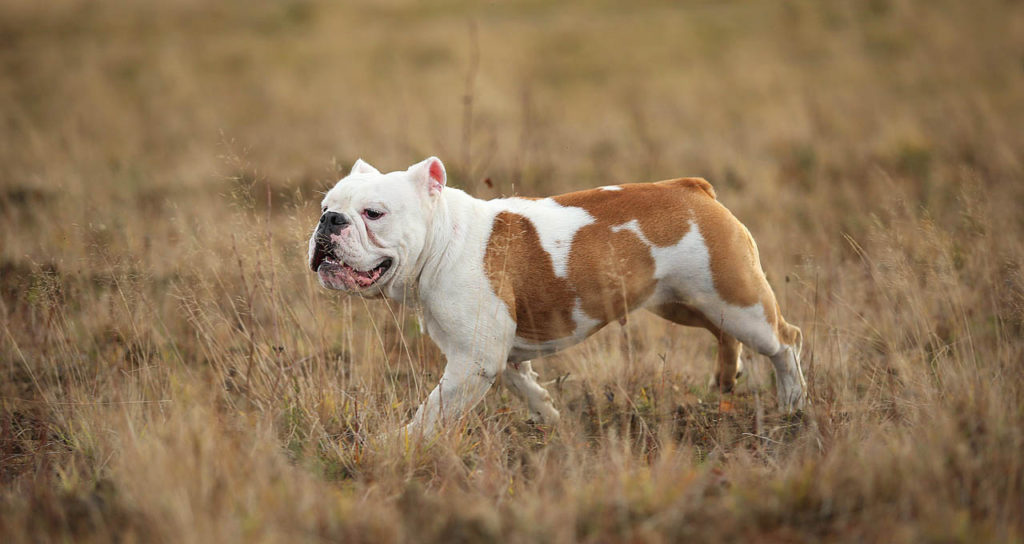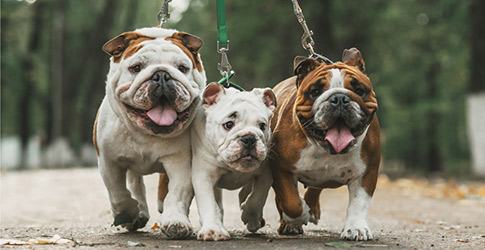The Bulldog, also known as the British Bulldog or English Bulldog, is a medium-sized dog breed. It is a muscular, hefty dog with a wrinkled face and a distinctive pushed-in nose. Bulldogs are popular pets; they were the fifth most popular pure breed in the US in 2017 according to the American Kennel Club.
Bulldogs have a longstanding association with English culture, as the BBC wrote: “too many the Bulldog is a national icon, symbolizing pluck and determination.” During World War II, Bulldogs were often likened to Prime Minister Winston Churchill and his defiance of Nazi Germany. When the English settled in the Americas, their Bulldogs came with them. Dedicated bulldog fanciers formed The Bulldog Club (England) in 1878, and the Bulldog Club of America in 1890.
Appearance
Bulldogs have characteristically wide heads and shoulders along with a pronounced mandibular prognathism. There are generally thick folds of skin on the brow; round, black, wide-set eyes; a short muzzle with characteristic folds called a rope or nose roll above the nose; hanging skin under the neck; drooping lips and pointed teeth, and an underbite with an upturned jaw. The coat is short, flat, and sleek with colours of red, fawn, white, brindle, and piebald.
In the United Kingdom, the breed standards are 55 lb (25 kg) for a male and 50 lb (23 kg) for a female. In the United States, a typical mature male weighs 50 lb (23 kg), while mature females weigh about 40 lb (18 kg). The Bulldog Club of America recommends the average weight of a bulldog to be 40–50 lb (18–23 kg).
Bulldogs are one of the few breeds whose tail is naturally short and either straight, screwed or thin and thus is not cut or docked as with some other breeds. A straight tail is a more desirable tail according to the breed standard set forth by the BCA if it is facing downward, not upwards.
Temperament

According to the American Kennel Club (AKC), a Bulldog’s disposition should be “equable and kind, resolute, and courageous (not vicious or aggressive), and demeanor should be a pacifist and dignified. These attributes should be countenanced by the expression and behavior”.
Breeders have worked to reduce/remove aggression from these dogs. Most have a friendly, patient, but stubborn nature. Bulldogs are recognized as excellent family pets because of their tendency to form strong bonds with children.
Generally, Bulldogs are known for getting along well with children, other dogs, and other pets.
History
A 2004 UK survey of 180 Bulldog deaths puts the median age at death at 6 years 3 months. The leading cause of death of Bulldogs in the survey was cardiac related (20%), cancer (18%), and old age (9%). Those that died of old age had an average lifespan of 10 to 11 years. A 2013 UK vet clinic survey of 26 Bulldogs puts the median lifespan at 8.4 years with an interquartile range of 3.2–11.3 years. The UK Bulldog Breed Council website lists the average life span of the breed as 8–10 years.
Statistics from the Orthopedic Foundation for Animals indicate that of the 467 Bulldogs tested between 1979 and 2009 (30 years), 73.9% were affected by hip dysplasia, the highest amongst all breeds. Similarly, the breed has the worst score in the British Veterinary Association/Kennel Club Hip Dysplasia scoring scheme, although only 22 Bulldogs were tested in the scheme. Patellar luxation affects 6.2% of Bulldogs.
Some individuals of this breed are prone to interdigital cysts—cysts that form between the toes. These cause the dog some discomfort but are treatable either by a vet or an experienced owner. They may also suffer from respiratory problems. Other problems can include cherry eye, a protrusion of the inner eyelid (which can be corrected by a veterinarian), allergies, and hip issues in older Bulldogs.
Over 80% of Bulldog litters are delivered by Caesarean section because their characteristically large heads can become lodged in the mother’s birth canal. The folds, or “rope”, on a Bulldog’s face should be cleaned daily to avoid infections caused by moisture accumulation. Some Bulldogs’ naturally curling tails can be so tight to the body as to require regular cleaning and ointment. Due to the high volume of skin folds on the Bulldog’s body, they have a high prevalence of skin-fold dermatitis.
Like all dogs, Bulldogs require daily exercise. If not properly exercised it is possible for a Bulldog to become overweight, which could lead to heart and lung problems, as well as stress on the joints.
Like all brachycephalic dogs, bully breeds often suffer from brachycephalic airway obstructive syndrome. The condition manifests in a variety of ways, often in the form of intolerance to heat and physical exertion. The English bulldog is among the breeds that are most severely affected by brachycephalic airway obstructive syndrome. Bulldogs have very small nasal cavities and this makes them have great difficulty keeping their bodies cool. Bulldogs are very sensitive to heat. Extra caution should be practiced in warmer climates and during summer months. Bulldogs must be given plenty of shade and water and must be kept out of standing heat. Air conditioning and good ventilation are required to keep them healthy and safe. Bulldogs actually do most of their sweating through the pads on their feet and accordingly enjoy cool floors. Like all brachycephalic, or “short-faced”, breeds, Bulldogs can easily become overheated and even die from hyperthermia. Bulldog owners can keep these issues under control by staying aware and protecting their Bulldog(s) from these unsafe conditions. They can be heavy breathers and tend to be loud snorers; another indicator of brachycephalic airway obstructive syndrome. In 2014 the Dutch Kennel Club implemented some breeding rules to improve the health of the Bulldog. Among these is a fitness test where the dog has to walk 1 km (0.62 miles) in 12 minutes. Its temperature and heart rate have to recover after 15 minutes.
In January 2009, after the BBC documentary Pedigree Dogs Exposed, The Kennel Club introduced revised breed standards for the British Bulldog, along with 209 other breeds, to address health concerns. Opposed by the British Bulldog Breed Council, it was speculated by the press that the changes would lead to a smaller head, fewer skin folds, a longer muzzle, and a taller thinner posture, in order to combat problems with respiration and breeding due to head size and width of shoulders.
In 2019, the Dutch government forbade breeding of Bulldogs.
